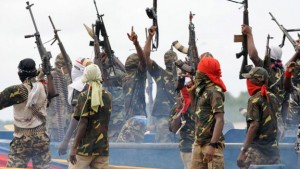The event followed a now familiar pattern: a small convoy of dusty 4×4 vehicles drove on to the edge of the airstrip at Galkayo in Puntland, north-central Somalia; armed security guards took up watchful positions nearby and a number of bemused-looking men stepped gingerly from the cars and lined up to have their photographs taken by the media.
On this occasion there were 11 of them; all had been hostages until that morning. They were sailors from a Malaysian cargo vessel that had been hijacked by Somali pirates a few years ago and held until a ransom was paid for their release.
One of them gave a brief account of what had happened. “On November 26, 2010 our ship was hijacked in the Indian Ocean. Their demand was 20 million. After that, they threatened the owner. You now increase money or we will shoot the crew. The owner didn’t increase the money and then one Indian is shot with just three bullets. Then they hit us and tortured us. Tell your family to bring us money, otherwise we will kill you!”
The crew had been held for three and a half years but they were the fortunate ones. Five of their crew mates had died in that time. Now the survivors were going home and a UN plane with two envoys on board was flying in to see them to safety.
Such scenes have become relatively commonplace in Galkayo in recent times. Eighty percent of global trade is carried by sea and Somalia sits on a key maritime route linking Europe and Asia. More than 18,000 ships pass its shores every year. Over the past decade, Somali pirates, often former fishermen whose traditional livelihoods have been destroyed by foreign trawlers and toxic waste dumping, have attacked more than 300 vessels and kidnapped 700 people.
Faced with such a threat, the international community responded aggressively. In 2008, European states, the US and others began sending naval forces to these seas. They are still there today – warships, planes and helicopters patrolling thousands of square miles and doing a fair job of keeping the hijackers at bay. The UN and others have also played an increasing role in facilitating negotiations for the release of hostages – such as those set free at places such as Galkayo – for whose liberty large ransoms have been paid.
But if the problem is now slowly coming under control in Somalia, the same cannot be said for other parts of the world where piracy is on the increase. Lawlessness, desperation, poverty, greed and even political radicalism have brought the phenomenon to the waters of South America, Asia and, perhaps most aggressively, to West Africa.
In an effort to understand the reasons why, Bertrand Monnet, a French academic and filmmaker, has been travelling to piracy hot spots around the coast of Africa. In an extraordinary and very tense series of encounters, he came to face to face with heavily armed pirate gangs operating in and around the Niger Delta, where Nigeria’s huge offshore oil industry, which employs thousands of expatriates, offers rich ransom pickings. It gradually became clear that piracy in West Africa has many of the same root causes as piracy in Somalia and elsewhere, not least of which is that those who don’t share in the benefits and profits of global trade have ever fewer reasons these days to respect the security of those who do.
aljazeera.com



